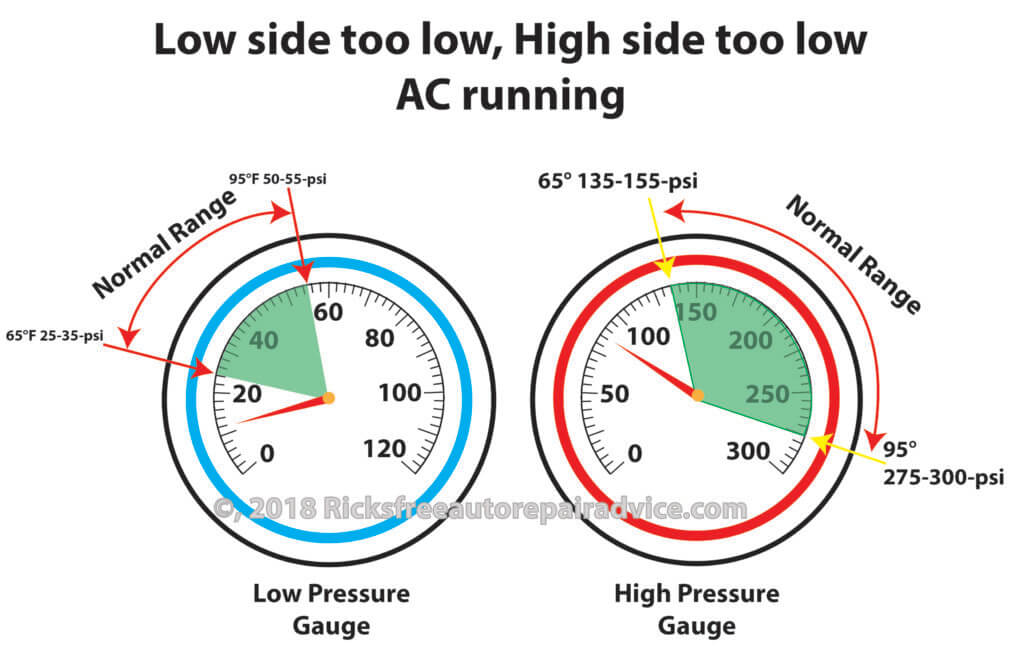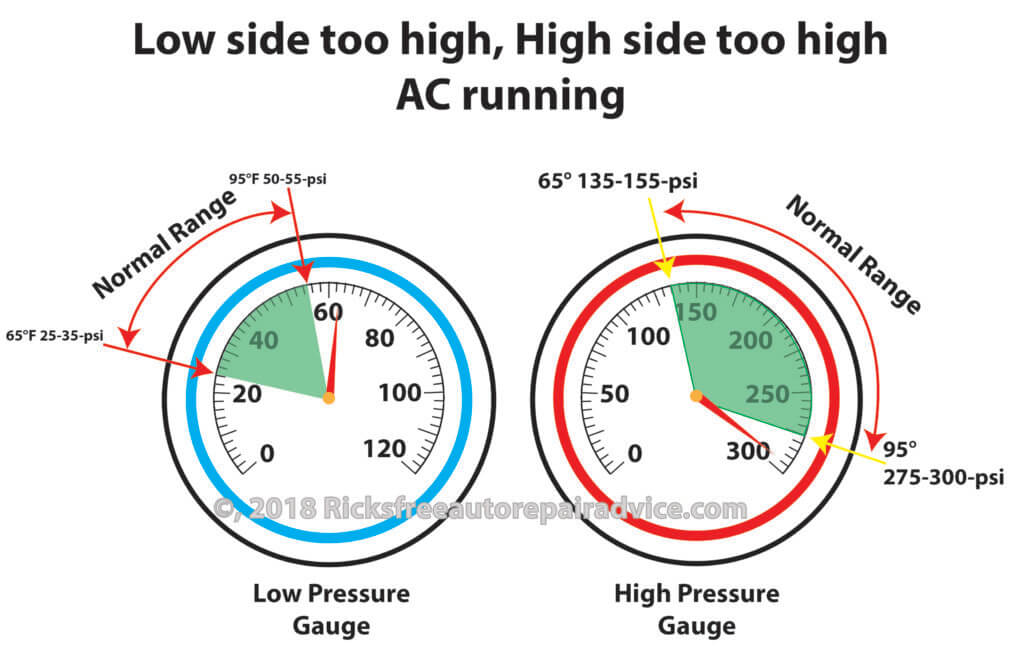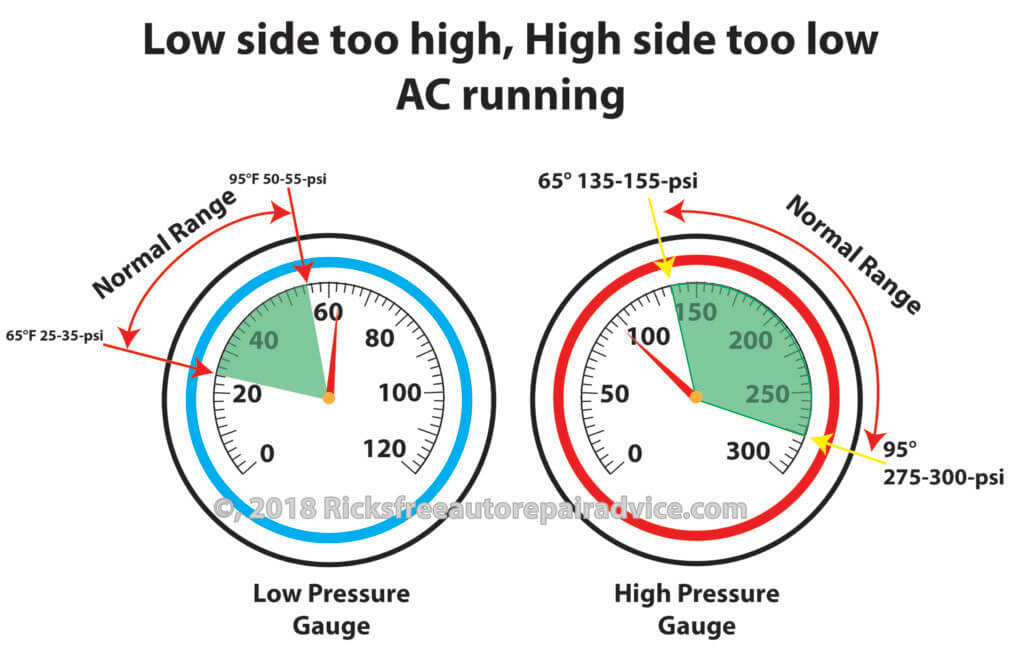Abnormal AC pressure gauge readings and the causes
Learn what car AC pressure gauge readings are abnormal and their most common causes
AC pressure gauge readings that are abnormal can give you a hint of the problem. Here are some examples of abnormal air conditioning pressures in a car that could indicate an issue with the AC system: This is the second part of a series on AC pressure gauge readings. If you missed part I, start here.
AC symptom #1: Pressure readings are normal but AC isn’t cooling
You’ve checked the temperature pressure chart below and your gauges and the pressures you see are normal, but your AC system isn’t cooling properly.
Ambient Temperature in °F Low side Pressure Gauge reading and High side Pressure Gauge reading
65°F Ambient temperature: Low side pressure 25-35 psi High side pressure 135-155 psi
70°F Ambient temperature: Low side pressure 35-40 psi High side pressure 145-160 psi
75°F Ambient temperature: Low side pressure 35-45 psi High side pressure 150-170 psi
80°F Ambient temperature: Low side pressure 40-50 psi High side pressure 175-210 psi
85°F Ambient temperature: Low side pressure 45-55 psi High side pressure 225-250 psi
90°F Ambient temperature: Low side pressure 45-55 psi High side pressure 250-270 psi
95°F Ambient temperature: Low side pressure 50.55 psi High side pressure 275.300 psi
100°F Low side pressure 50-55 psi High side pressure 315-325 psi
105°F Ambient temperature: Low side pressure 50-55 psi High side pressure 330-335 psi
110°F Ambient temperature: Low side pressure 50.55 psi High side pressure 340.345 psi
Here are the possibilities
1) The blend air door or actuator isn’t working properly and you’re getting heated air from the heater core that’s mixing with the cooled air from the AC. Check blend door operation by turning the temperature dial on your car’s HVAC and watching blend door operation. If your car has a heater valve, make sure it’s not allowing hot coolant into the heater core when you’re running the AC.
Fix: Replace a bad blend door actuator or faulty heater control valve or repair a faulty blend door or blend door linkage
2) You have air and humidity in the system from leaks and refills over the years. Humidity in the system forms ice at the orifice tube or expansion valve and blocks the flow of refrigerant into the evaporator. Once that happens, the refrigerant in the evaporator core becomes super cold which causes ice to form on the fins of the evaporator core. In other words, the evaporator core ices up and stop cooling. Then, since no more refrigerant is flowing, the evaporator warms up, the ice melts and you get warm air. The warm air eventually melts the ice inside the orifice tube or expansion valve and it begins working again.
Fix: Evacuate the system. Check for debris on the orifice tube screen. Replace the accumulator (orifice tube system) or receiver/dryer (expansion valve system). Pull a vacuum to remove all moisture. Recharge.
3) The heater core is leaking warm coolant into the heater box. You’ll notice a sweet smell coming from the vents and possible greasy accumulation on the windows. Engine coolant levels will be low.
Fix: Replace leaking heater core
AC symptom #2: Low side pressure is too low, High side pressure is too low

Here are the possibilities
1. This could be normal if outdoor temps are very low.
Fix: None needed. Check again when the temperature rises
2) Low refrigerant charge (most common cause).
Fix: Check for leaks and repair. Evacuate the system and recharge with the correct amount of refrigerant.
3) Partial blockage of the orifice tube/expansion valve and the evaporator. The blockage or stuck expansion valve restricts the flow of refrigerant into and out of the evaporator.
Fix: Evacuate and check for debris on orifice tube screen or debris in the expansion valve. Replace clogged orifice tube and flush hoses. Install an in-line filter to prevent re-occurrence. Replace expansion valve, flush and install in-line filter.
4) Blockage on the high-pressure side of the system between the compressor and condenser but before the high-pressure port. Evacuate and check for blockage.
AC symptom #3: Low side pressure is too high, High side pressure is high

Here are the possibilities
1. This could be normal if outdoor temperatures are very high.
2. The system is overcharged. (very common especially if you’ve tried to add refrigerant yourself)
Fix: Remove excess refrigerant or evacuate and recharge with the correct amount.
3. Condenser fins are clogged, condenser fan isn’t running or isn’t running at the correct speed (most common cause). Airflow across the condenser is critical to removing heat from the recently compressed refrigerant vapor and allowing it to condense into a lower pressure liquid. Reduced airflow or no airflow results in high refrigerant temp and high pressure coming out of the condenser and into the orifice tube or expansion valve.
Fix: Clean condenser fins and check for dented condenser tubes. Check condenser fan operation.
4. Compressor regulator valve is faulty
Fix: Replace regulator valve
5. Blockage on the high-pressure side of the system between the compressor and condenser but before the high-pressure port. Evacuate and check for blockage.
AC symptom #4: Low side pressure is too high, High side pressure is low or normal

Here are the possibilities
1. Expansion valve stuck open
©, 2020 Rick Muscoplat
Posted on by Rick Muscoplat